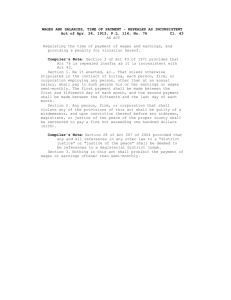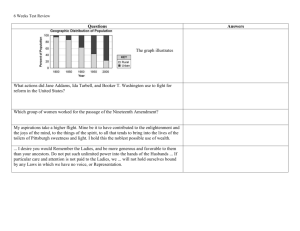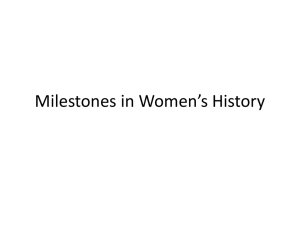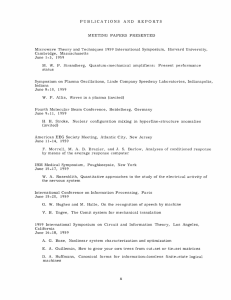the effects of industrialization on american women's
advertisement
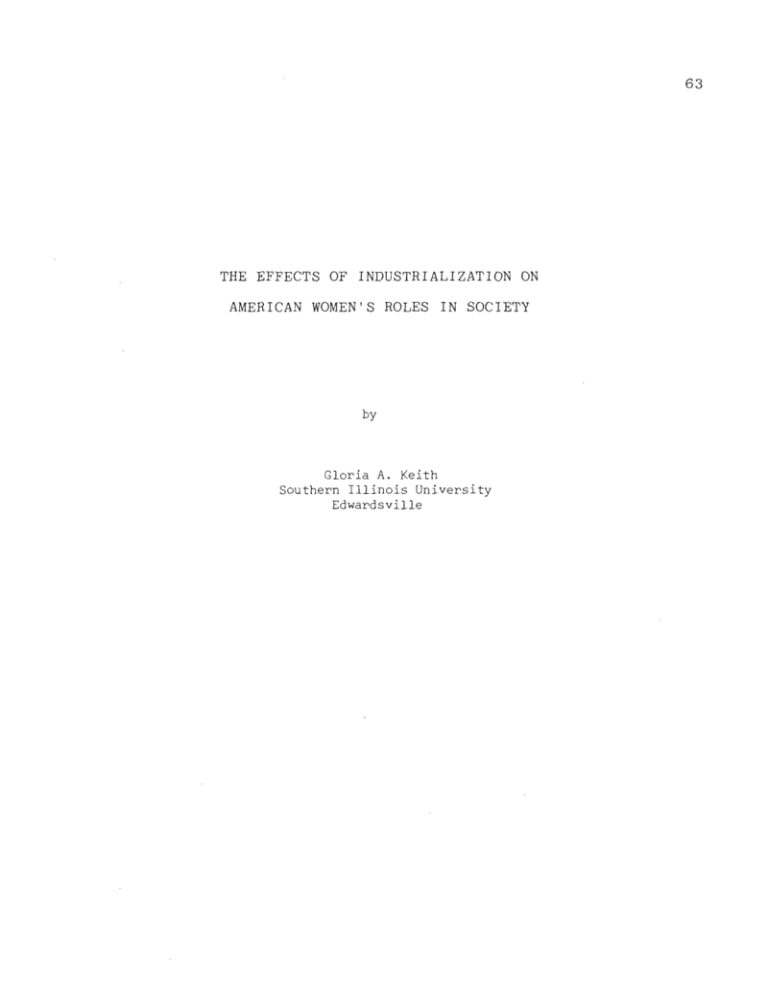
63 THE EFFECTS OF INDUSTRIALIZATION ON AMERICAN WOMEN'S ROLES IN SOCIETY by Gloria A. Keith Southern Illinois University Edwardsville 64 As I set out to do my research for this paper, I was amazed at the amount of literature pertinent to the issue that had been written before the onset of the so-called "Female Revolution". Like the greater majorjty of my sex, I had heard of Susan B. Anthony and the women suffragettes who advocated "Women's Rights" in the late nineteenth - early twentieth century, but was unaware of the many other women who had made important contributions in the areas of labor organization, education rights for women, medicine, literature, etc. In pre-industrial or traditional societies, the division of labor followed the culturally defined rules handed down through the generations. As a pattern it is associated with extended patriarchal families with a rural or peasant economy (Martin & Voorhies 1975:367). Under the traditional dichotomy of labor the males took over the provider role, while the female became the domestic helper. The advent of settled community life and increased production of agricultural products led to the establishment of the urban dweller, and urbanism became the accepted alternative to agricultural life. City dwellers in pre-industrial times, were artisans, craftsmen, merchants, etc., and exchanged their products and services for their subsistence needs. led to an adjustment in the family. longer a viable unit. unit This new way of life The extended family was no The new economic base led to a new family the conjugal pair and their offspring. With the advent of a new family unit the role of the female asa co-producer assumed a new importance. 65 Among the lower class families the productive efforts of the males were sometimes inadequate for the subsistence of the family; and the female, more often than not, found herself work- ing outside the home at a full or part time job, plus carrying her usual responsibilities for her own family. Without the services of an extended family to fall back upon, this was an additional harder burden borne by the women. As they had no training or formal education, their job opportunities were mostly confined to the domestic services at an extremely low rate of pay, with long hard hours. With the invention of machinery (i.e., the spinning jenny and the power loom) which were designed to boost the production of needed commodities and to create a demand for an easier access to manufactured goods, the age of industrialization had begun (Cooke & Bunch-Weeks 1970:99). The Civil War accelerated the development of industry, which was already on a substantial footing in the New England States. The need to equip and maintain large armies and outfit the western expansion brought about a large scale growth. American business had begun to mature. The Civil War by its drain on the manpower reserves of the country, especially in the North, forced thousands of women into the labor market. While for many this was a temporary step until their men returned home from the War, thousands were left as the sole breadwinner in the family because of the death or disability of their husbands, fathers, or brothers. Single women with no relatives to fall back upon, and widows who now had sole responsibility for the upkeep of fatherless children were forced into the labor market and their numbers rose steadilS7 • This is borne 66 out by the official census figures covering a twenty year span (Flaxner 1959:131). 1850 1860 1870 225,922 270,987 323,370 In the first half of the nineteenth century, women worked in more than a hundred industrial occupations. At first, some of these occupations, the making of cloth, garments, and hats, and the sewing of shoes, were carried on in the home where they had first engaged in them as housewives. This arrangement enabled the women to keep an eye on their children and undertake more pressing duties of their housework in between completing their sewing. But, with the invention of machinery the home work shrank; there was a steady demand for women workers in the textile mills, but opportunities for factory work could not keep pace with the number whom mechanization had thrown out of work. With no skills which were in economic demand except some sort of sewing, many women found themselves in desperate competition with one another in the garment industry, which was still largely carried on at home. These were not the only factors making for low earnings in this field. The concept of the inferiority of women barred them from training for more skilled work, and therefore for entering other occupations; it also prevented their receiving the same pay as a man for similar work. A newspaper in 1833 estimated that "women earned only one fourth of men's wages", while still another asserted that three fourths of Philadelphia's working women "did not receive as much wages for an entire week's work of 13 to 14 hours per day, as journeymen receive in the same branches for a single day of 10 67 hours" (Flaxner 1959:53). The result was that women homemakers in 1833 were averaging as little as $1.25 a week, or less; a childless woman might earn an average of $58.50 a year, but one encumbered by young infants needing her care would only make an average of $36.40 annually. An estimate puts women's daily average earnings at less than 37~ cents, with thousands earning a mere 25 cents a day. It was among these women, working in slum dwellings under conditions similar to those of the modern sweatshop, that the desire first emerged for contact with one another and joint action to better their conditions. Out of their plight came such short- lived organizations in the 1830's as the United Tailoresses Society of New York, the Lady Shoe Binders of Lynn, Massachusetts, and others across the industrialized states. Their rudimentary attempts to band together and withhold their labor met with little success. The women were not only inexperienced and working in isolation from one another, but they received little support from the men in their trades, whose attitude generally was one of fear that women's low earnings would compete unfavorably with their own. If pay was higher and conditions in general somewhat better in the cotton and woolen mills, the difference was only relative. The typical factory working day lasted from sunup to sundown, and sometimes until after lighting up time. 15 or 16 per day. The hours ran from 12~ Women and children had to be at work at 4:30 A.M. and work as long as they could see, with time off for breakfast and dinner. to Women's wages, always lower than those of men on similar jobs, ranged from $1.00 to $3.00 a week, out of which they paid either $1.50 or $1.75 per week for board in company owned or leased houses (Flaxner 1959:55). 68 Their basic problem was their own weakness, even when their militancy was greater and more sustained they could achieve nothing lasting. The first early flowering of the women's rights struggle, having put forth a tender, fragile bloom, quietly withered on the stalk. The next surge of organization among women workers did not come until the emergence of the Knights of Labor in the 1880's. Women of means, with contacts and influence, such as those who kept the nascent suffrage movement alive for 6ecades, had not yet become interested in the problems of working women, or seen the relationship between their goals; they did not do so, on any appreciable scale, until the turn of the century. But the grievances remained --- low, unequal wages, the long hours, the indignities inflicted by foremen and employers, illness resulting from the working conditions, child labor after the age of five and no supervision available for the younger infants and the unremitting sporadic, unsuccessful attempts to organize against them also continued. However fugitive they might appear, they showed the way to those who came after, and who succeeded in building more enduringly. The late nineteenth century was a period of huge and rapid industrial growth. Standard Oil Company was founded, by lead, steel, tobacco and distilling industries. followed Railroads also made great advances becoming trans-continental in scope. Cheap labor, always a need for these giant corporations, was easily obtainable from the influx of immigrating Europeans. Women were in great demand of course, for the lowest paying jobs, and their employment rose from the 2,647,000 of 1880 to 4,005,500 by 1890. A rise from 15.2% to 17.2% of the total 69 working force (Flaxner 1959:193). Although the size of the labor force was escalating sharply, the wages were kept low by the use of immigrant labor. As a result the 1880's saw the first serious attempt to organize a national labor organization. The Knights of Labor began organizing working men and women on an equal basis. Unfortunately, the organization increasingly demonstrated its inability to unite in behalf of any course at all, and rapidly disintegrated within a decade. Throughout the 1890's and early 1900's women continued their sporadic and usually unsuccessful attempts to form unions. Some were completely independent unions and these, lacking resources and experience usually fared the worst; others were socalled "federal locals", chartered by the American Federation of Labor and limited to women in one trade. Attempts by the Federation to organize women on any large scale foundered on the disinclination of the majority of its unions to spend money organizing low-paid, unskilled trades far removed from their own immediate interests. In 1892 the American Federation of Labor finally appointed a woman organizer (Flaxner 1959:201~ for a term of five months. Mary E. Kenney was a bindery worker, who in her home town of Boston had organized a Ladies Federal Union. During her brief tenure as an organizer she worked with women in a number of industries in the New England States. The Federation officials were not enthusiastic supporters of her work, and it was discontinued long before she had received a chance to prove its value. Fortunately, Miss Kenny's interest in organizing women was less ephermeral, and she became one of the moving forces, some ten 70 years later, in the founding of the Women's Trade Union League (Firestone 1970:22). As is the case with all rapid changes in a society, the rapid development of a predominantly industrial society brought about increased productivity and wealth, but also heightened the poverty and social tension. Pyramiding incomes at one end of the scale were in acute contrast with the sweatshops and congested slums on the other end. Violent industrial struggles took place between the employers, anxious to retain the open shop and cheap labor so vital to their huge profits, and the growing labor movement. A number of church leaders became troubled with the gap between their Christian ethics and the glaring inequities of life visible all around them, and began to speak out, demanding reform. In the middle of the ferment new organizations dedicated to the cause of social justice sprang forth, of the affluent classes. founded by women These women, including Grace Dodge, Josephine Shaw Lowell, and Jane Addams were thereby enabled to bridge the gap between their own sheltered lives and the women working in stores and factories who needed their help. Out of their joint efforts came, not only the settlement houses, but such organizations as the Working Girls Clubs, the National Consumers League, and the Women's Trade Union League, which brought women workers new allies possessed of money, influence, and dedication (Firestone 1970:22). The heightened tempo of protest and fresh intellectual activity sent increasing numbers of girls to college and into the professions, and it eventually heightened the agitation for 71 women's suffrage as well. At every turn such women were faced with the handicap of their utter political impotence, and with the exception of Grace Dodge, 0very woman who was to any degree active in the social reform movement Has also an active and articulate suffragist. It cannot be repeated too often that for women working a 10 or 12 hour day whose earnings were almost half those of men, whose lives were often bounded by the sweatshop, and whose relation to their employer lacked any safeguards to personal dignity or job tenure, "equal rights" was a question of more than education or getting the vote. For them equality also meant better pay for their labor, security from unsafe working conditions or the unwanted attentions of a foreman, political and economic freedom from their husbands, and a chance to get home to their domestic tasks before complete exhaustion had overtaken them. By the beginning of the twentieth century, some changes had taken place in the position of women in America. While changes in the educational and legal positions of women had been uneven from one state to the next, and had not always taken place without setbacks, nevertheless, many of the worst disabilities had been eliminated, while others had been greatly reduced (Francis 1061:?'1). By this time the leaders of the various women's unions and organizations had come to realize that without political power their movement would never get off the ground. Therefore, they began to put their considerable capabilities and energies to the task of passing an amendment to the Federal Constitution. Over the ensuing years the battle 72 waged back and forth until in August 1920 final ratification was achieved and the Nineteenth Amendment became the Law of The Land. Now, almost fifty-five years after the adoption of the Nineteenth Amendment --- what are the changes? A number of promised or threatened events have failed to materialize. The millenium has not arrived, but neither has the country's social fabric been destroyed. Nor have women organized a political party to elect only women candidates to public office. Instead, women have shown the same tendency to divide along orthodox party lines as male voters. They have, it is true, voted in steadily increasing numbers, but the increase does not match their growth in the total population, nor does it adequately reflect their potential political power. Women have exercised some of the healthy influence dreaded by the machines in favor of "good government", even though in most cases they are limited to "women's jobs" and "women's sub'jects" (health and education), which politicians consider theirs based on sex. Their political influence, such as it is, has so far been most effectively exerted through their own organizations --the League of Women Voters, Parent Teachers Associations, clubs, etc. After the long battle for the passage of the Nineteenth .- Amendment, Mrs. Catt -- leader of the Women's Suffragist Move- ment -- warned that it was only the beginning, and that women would have to force their way behind the "locked door" where the real decisions were made: "You will have a long, hard fight before you get behind that door, for there is the engine that moves the wheels of your party machinery ... If you really 73 want women's vote to count, make your way there" (Flaxner 1959:327). The task of cracking the political machines has proved an arduous and, on the whole, still an unsuccessful one in which women have faced such varied obstacles as their own distaste for the rough and tumble of machine politics and the prejudices of the male politicians, and sadly to say -- the prejudices of their own sex. In addition, there are the problems encountered by every woman who attempts, in addition to making a home and rearing children, to carryon a business or professional career of any kind. The truth is that while most of the legal barriers are down, others remain, some of them rooted in physiology, others arising more from prejudice than fact. The problem of the child-bearing mother who wishes to bring up her children, but must interrupt her career to do so, seems likely to remain a continuing one in the foreseeable future despite labor saving devices, hew educational concepts, and the growing willingness of fathers and husbands to take on a share of household and family responsibility after they come home from work. The single woman, widow or divorcee (with or without children) continues to pay a heavy forfeit for her sex. Because so many women do marry and bear children, business firms or educational institutions are reluctant to train or promote a talented young woman who is likely, they feel, to cancel their investment in her by marrying, bearing children, following her husband, or both. There seems to be a valid basis for women's complaints that they need to be better than the best to get ahead. 74 At the same time, however, more women are going to work, and working for longer periods in their lives. Although the relationship between the employment of women and family income is complex and variable, the increase in the number of women workers in such groups as young married mothers with small children and of older women shows that at least a large proportion work because they must, either as their principal means of support or as a necessary supplement to the family income. Yet the differential between men's and women's earnings continues to widen, in the face of mounting taxes and still rising price levels. On the surface it looks as if women's progress has a tendency to run in ever increasing circles as we are once again pinning a vast amount of hopes to another amendment to the Federal Constitution. The Equal Rights Amendment is being heralded as our "Great White Hope", the one that will en.d all our problems in one fell swoop by the simple act of prohibiting any discrimination on account of sex. The question is whether any amount, or type, of legislation can overcome any type of discrimination purely because it is prohibited by law. It is my personal belief that while industrialization has been the forerunner of many social, economic and legal changes in the lives of women, the end is not yet in sight. In the years to come there will be, and must be, many more changes in our cultural and social values to enable women to take their rightful place, alongside men, in the future. 75 BIBLIOGRAPHY Adams to de Beauvoir ]961 Thc~ Feminist Bantam Books, Edi.tvd by: Alice S. Inc., New York. Pa.pf~rs. Cooke, Joanne and Bunch-Weeks, Charlotte 1970 The New Woman. Bobbs Merrill Co., Firestone, Shulamith 1970 The Dialectic of Sex. Inc., New York. Ro~si, Inc., New York. William Morrow & Company, Flaxner, Eleanor 1959 Century of Struggle. The Belknap Press of Harvard, University Press, Cambridge, Mass. O'Neill, Barbara Powell 1965 Careers for Women After Marriage & Children. The Macmillan Co., New York. Schwartz, Felice N., Schifter, Margaret H., and Gillotti, Susan S. 1972 How To Go To Work When Your Husband Is Against It, Your Children Aren't Old Enough, and There's Nothing You Can Do Anyhow. Simon and Shuster, New York. Francis, Philip The Legal Status of Women. 1963 New York. Cutler, John Henry 1961 Nine to Five and After. Garden City, New York. Bryn, Katherine 1975 Sexism in Science. New York. Oceana Publications, Doubleday & Company, Inc. Science Digest, December, Davies, Margaret Llewelyn 1975 Life As We have Known It. New York. Martin, M. Kay and Voorhies, Barbara 1975 The Female ot the Specieso Press, New York & London. W. W. Norton & Co. Inc., Columbia University Gordon, Michael 1972 The Nuclear Family In Crisis: The Search for an Alternative. Harper & Row Publishers, New York. 76 BIBLIOGRAPHY (cont.) Ford, Clellan S. & Beach, Frank A. 1951 Patterns of Sexual Behavior. New York. Harper Brothers, Bardwick, Judith 1971 A Study of Bio-Cultural Conflicts. Row, New York. Harper and
